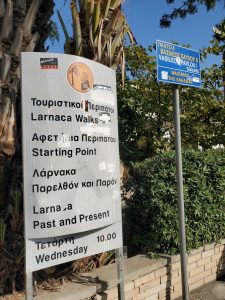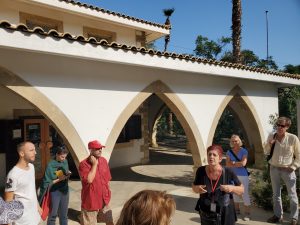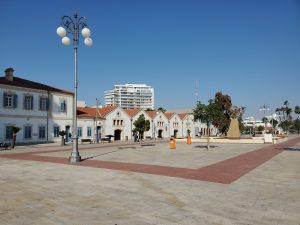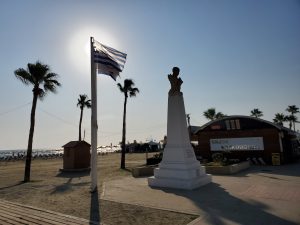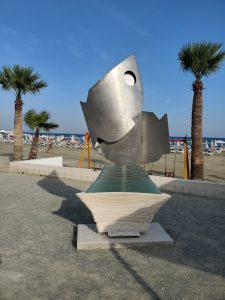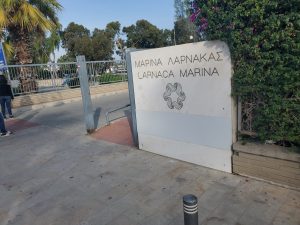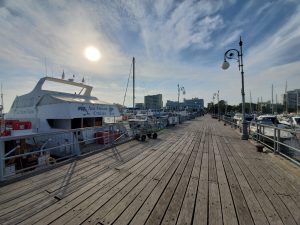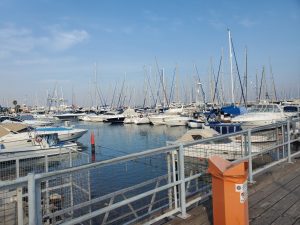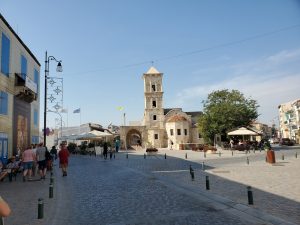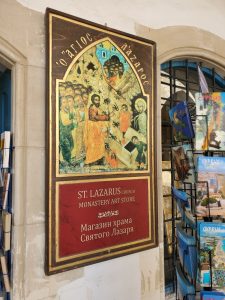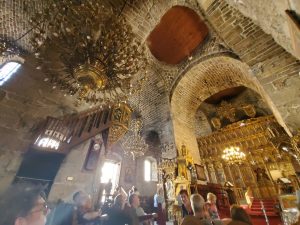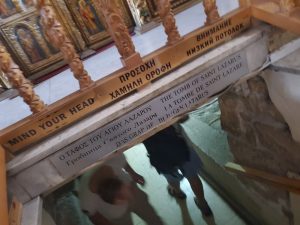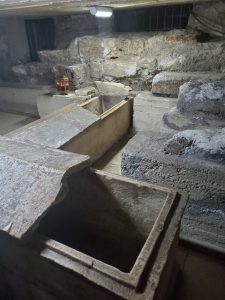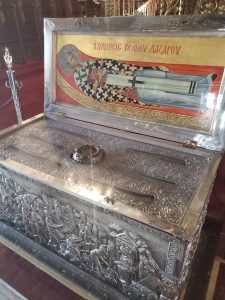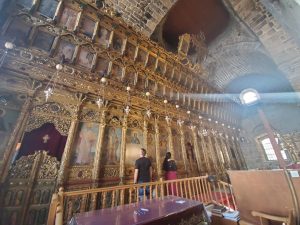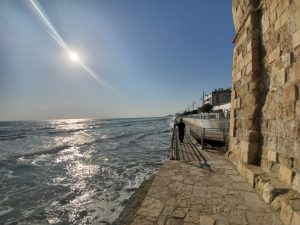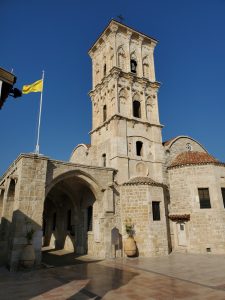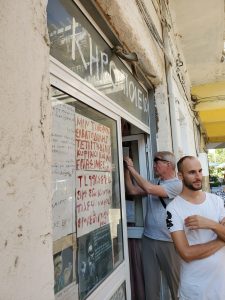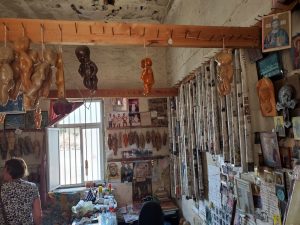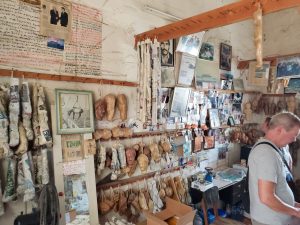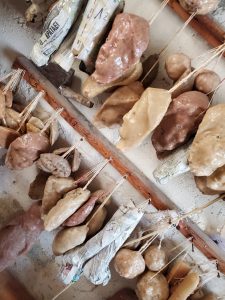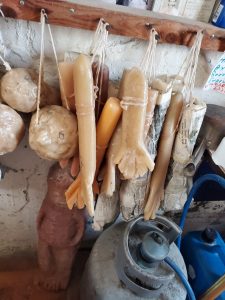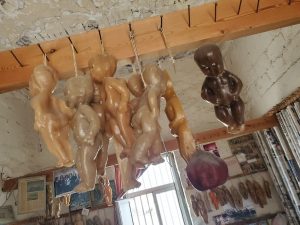Context is everything.
So when the free walking city tour began and our tour guide pointed to various buildings and palm trees along the sea front walkway, I thought I knew what she meant by “these things are very old.” I had just come from Athens where the Parthenon is some 2500 years old. And even in the short time I was in Cyprus I was told that there were archeological strata from the various conquerers dating back to the 5th, 6th, 7th century BC… and earlier. So when she continued and said the tallest palms had been planted in 1922 and that some of the roadhouses in European Square dated to the late 1800s, well, I was nonplussed at that “old”age. But the Obi Wan Kenobi adage is true — you will find that many of the truths we cling to depend greatly on our own point of view.
Because those ARE old palm trees. And they ARE old buildings now preserved. But they’re also not very old, ya know?
Anyway, the ocean front street is called Athens Way… but none of the locals call it that. They call it Finikoudes, roughly translated as “palm tree seafront.” It marks the beginning of the town center — the next two parallel streets serving as the main shopping corridors. It’s perhaps odd to think of the town center as the sea front, but the truth is Larnaca is a sea port town. It always has been. And the focus therefore has always been on the waterfront.
Cyprus floats as a crossroads of three continents – Europe, Asia, and Africa. And as such, it made for a strategic military point, as well as a commercial strategic point. In the game of Risk, it would be like Kamchatka… even though Kamchatka is a real place on the eastern seaboard of Russia, the point is that there’s a RISK game theory that whoever controlled Kamchatka, controlled the world. Cyprus was a linchpin and as such kept getting conquered as empires rose and fell.
Today it’s still a great crossroads for the seas and its marina is ever so popular with the super yacht crowd because you can moor your boat, step off onto the pier and stroll to the town center tout suite. It’s a great central point to use a base to explore other parts of this area and it affords maintenance options amidst the open seas.
The founding of the city dates to Kition, which lies about 20 minutes from the city center. Experts believe there’s a connection to Kittim, the grandson of Noah. And because of the city’s proximity to water, there’s a lot of festivals that are water based — Noah and the Flood, Aphrodite is the Sea Goddess of Greece and is the patron God of Cyprus, etc.
In the stone age, humankinds make an appearance on Cyprus most possibly by boat. But our guide said there’s not a lot to see archeologically save for the stone foundations of former “houses.” If you read my take on Athens, there’s only so much broken stones that are just crumpled masses that I can look at without kinda taking it for granted.
The copper age was ushered in because copper was apparently first discovered in Cyprus and therefore it became a rich trading post. The Phoenicians came with their alphabet and established their first port here.
There’s a lot of conquering that goes on throughout the BC centuries, but ultimately it’s the Persians who win out for a long time. There was an effort lead by the Athenian general to liberate the island, and he was feared by the Persians. Unfortunately, he was mortally wounded in battle… but his last command was to tell his soldiers to keep it quiet and make like he hadn’t died to keep scaring the Persians. Alas, it wasn’t until much later when Alexander the Great would take the island from the Persians. Still, the city loved General Kimon, and in the 1920s they erected a statue in his honor with the inscription: “Victorious even in death.”
Speaking of Greeks, Zeno of Citium, a famous Greek stoic philosopher, came from Cyprus. Perhaps his most famous quote, the kind of thing we’d retweet now as internet meme, is “God gave us two ears and one mouth, so that we might listen twice as much as we speak” (paraphrased).
Traveling through time like we were dusting crops, the Roman era of Cyprus diminished the role of the city of Larnaca because Rome made Pathos on the western coast the capital.
However… as part of the Byzantium Empire, the Eastern Roman Empire, there was a big connection with St. Lazarus, the good friend of Jesus… the good dead friend of Jesus who Jesus brought back from the dead… not as a zombie but as a guy who feared being persecuted and fled to Cyprus to live out the next 30 years as an influential follower. In this second life, he even became Bishop of Cyprus. He would die, a second time, and be buried here… and atop his tomb a church was built… and then rebuilt in 890 AD using funds from the Byzantium Emperor. It was a quid pro quo – Cyprus gave him Lazarus’s bones, famed relics, and he built them a church.
King Richard III accidentally conquered Cyprus on his third crusade… but wanted to keep pushing on so tried selling the island. First he sold it to the Knights Templar but the local Cypriot population proved to be too much for them. So Richard III found another buyer — Guy de Lusignan, a French aristocrat who had just been kicked out of his Middle Eastern holdings… a king without a kingdom. So he took over Cyprus as his and introduced the feudal system. Welcome to progress, Cyprus — now the locals are all vassals and personal property is a thing of the past. Sigh.
The Venetians would take control some 300 years later and made Cyprus a trading superstar. Thanks to their obsession with protecting their investment, defensive walls and forts were established throughout the land… most notably in Nicosia (which I’m hoping to see later on). More walls were built. More walls. The more things change.
Despite all that defense spending, the Turks would muscle in and take over anyway.
During the Turkish Ottoman Empire rule of Cyprus (1571-1878), all church bells were banned because it interfered with the Islamic call to prayers. Bell towers were toppled… which is why in the photos below the bell tower has a different color scheme. It was rebuilt after the British took administrative control of Cyprus in 1878.
The reason the British took over was because Cyprus feared the rising influence of Tsarist Russia in Turkey and beyond. They cut a deal with Britain that they’d take over the administration of Cyprus in exchange for protection… nice country we got here… it’d be a shame if anything happened to it.
Flash forward to 1960 when Cyprus gains its independence. And then flash forward to 1974 when the Turks invaded Northern Cyprus. They claim it was because Cyprus was leaning toward merging with Greece proper, and the Turks therefore had to protect the 18% of the island population who were Turkish Cypriots. I suppose it’s where Putin got the idea for invading Ukraine. Anyway, at the time it was universally condemned and Northern Cyprus became a rogue nation. All Greek Cypriots living in the north fled to the south as refugees. All Turkish Cypriots living in the south were advised by Turkey to go North. In a weird “temporary” land swap, which is entering its 46th year, the forfeiture of property had local governments grant the northern Greek Cypriot refugees access to the now unoccupied Turkish Cypriot houses in the south.
In 2003, the first checkpoints between the rogue North and Cyprus was established… and yet today after four plus decades, 40,000 Turkish troops have continued to occupy and “guard” Northern Cyprus. It is a serious geo-political problem. The people themselves per usual are not the issue. It’s the “power elite” who continue to exploit differences and “otherness” and “extremists” as grounds for walls and separations.
I scribbled down one concluding word as I tried to work out the details of this complicated matter:
Crazy.
***
The Greek Orthodoxy Religion is big in Cyprus… with minority religions also kinda, sorta respected. Our guide kept talking about despite tensions on the global stage between foreign powers, the local people are all Cypriots. But she kept making distinctions between Turkish Cypriots and Greek Cypriots and between the local church and say the one still operating mosque or the Armenian church that all seemed like curiosities rather than aspects of the community.
But apparently in Greek Orthodoxy, candles are big — it’s believed that an effigy offering burned in the church can be helpful. Some people who are seriously ill ask for a life size candle model of themselves be made so that it can be burned in the church and they might be saved that way. Different ailments in different parts of the body make for different candle representations — hands, feet, you name it and they’ll dip it in wax so you can burn it. New parents might ask for a baby figure candle to burn in the church to pray for good health for their child. Wandering into one of those candle shops was the stuff of horror movie nightmares.
Viewer discretion is advised.
Ready?
I wrote down two words after walking out of that place, a location I could pitch six different serial killer lairs to my writer friends. Those two words:
Super creepy.
***
It feels off to finish this here because I actually am enjoying Cyprus. But we don’t always get to write the endings we want…. sometimes we just write the endings as they are.

